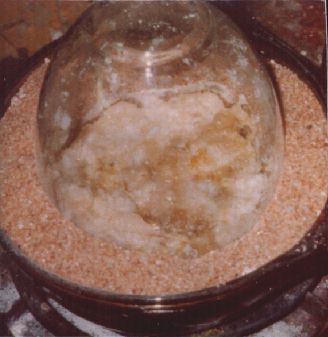
|
|
John Reid's Course on Practical Alchemy - II. Chapter 9.Third part.Back to main page of Course.  The darkness in the center of the matter seems to have compressed itself into bands. The top of the matter has a slimy, festering look about it.
Shows our matter about five an a half weeks into the process of putrefaction. Our matter has undergone a drastic change in its appearance. Notice now how the matter has sunken into itself. From the center radiating out to the edges is the appearance of a darker substance. It seems to be seeping up from the bottom of the matter and oozing through the surface. There is no doubt now that our matter is putrefying, it looks definitely like a rotting substance.
Shows the matter three days after the top center had been taken. From now on the matter would make drastic changes in its appearance every two to three days until the end of the putrefaction cycle.
Shows the matter at six weeks and one day. There is a dark liquid beginning to well up from within the matter and submerge it. The matter is at this point drowning or bathing in its own blood. That part of the matter that can be seen through the subject's blood looks to be rough and stony.
At six weeks and three days we see a close-up of the matter. The picture needs no further explanation. The substance is definitely rotting.
At six weeks and six days the entire surface of the matter is covered with its blood. You can still see some detail of the matter in spots that have not gone completely black.
This is the final picture in the putrefaction series. Our matter has gone completely black and has sunken in on itself. The surface of the matter has a shiny tar-like appearance, from the congealing blood of the matter. Approximately seven weeks has now elapsed. By continuing to heat the matter a state of dry blackness is achieved. It is only now that we can at last begin to raise the heat gingerly.
Shows the stone in the green stage. It takes about two to three weeks for this color to show itself.
Shows the stone in the white stage. At this time the stone been taken out of the kiln and ground fine. This was done to help the color changes take place more evenly. The color of the stone really at this point is slightly yellow. This is because it was taken out of the kiln too late to catch the pure white color.
Shows a completed stone. The old masters would call this a non-multiplied stone. Its color is a medium beige to light russet. The matter shown in this plate would have to go through at least two more revolutions of the processes to be called a true stone and reach a true red color. By doing this the matter is changed drastically, it really does have a wax-like consistency. The amazing thing about this substance is that it will tinge plant salts in flux, immediately elevating them to perfection.
|